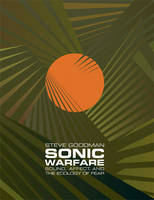
Sonic Warfare
Sound, Affect, and the Ecology of Fear
Seiten
2009
MIT Press (Verlag)
978-0-262-01347-5 (ISBN)
MIT Press (Verlag)
978-0-262-01347-5 (ISBN)
- Titel ist leider vergriffen;
keine Neuauflage - Artikel merken
An exploration of the production, transmission, and mutation of affective tonality--when sound helps produce a bad vibe.
Sound can be deployed to produce discomfort, express a threat, or create an ambience of fear or dread--to produce a bad vibe. Sonic weapons of this sort include the "psychoacoustic correction" aimed at Panama strongman Manuel Noriega by the U.S. Army and at the Branch Davidians in Waco by the FBI, sonic booms (or "sound bombs") over the Gaza Strip, and high-frequency rat repellants used against teenagers in malls. At the same time, artists and musicians generate intense frequencies in the search for new aesthetic experiences and new ways of mobilizing bodies in rhythm. In Sonic Warfare, Steve Goodman explores these uses of acoustic force and how they affect populations.
Traversing philosophy, science, fiction, aesthetics, and popular culture, he maps a (dis)continuum of vibrational force, encompassing police and military research into acoustic means of crowd control, the corporate deployment of sonic branding, and the intense sonic encounters of sound art and music culture.
Goodman concludes with speculations on the not yet heard--the concept of unsound, which relates to both the peripheries of auditory perception and the unactualized nexus of rhythms and frequencies within audible bandwidths.
Sound can be deployed to produce discomfort, express a threat, or create an ambience of fear or dread--to produce a bad vibe. Sonic weapons of this sort include the "psychoacoustic correction" aimed at Panama strongman Manuel Noriega by the U.S. Army and at the Branch Davidians in Waco by the FBI, sonic booms (or "sound bombs") over the Gaza Strip, and high-frequency rat repellants used against teenagers in malls. At the same time, artists and musicians generate intense frequencies in the search for new aesthetic experiences and new ways of mobilizing bodies in rhythm. In Sonic Warfare, Steve Goodman explores these uses of acoustic force and how they affect populations.
Traversing philosophy, science, fiction, aesthetics, and popular culture, he maps a (dis)continuum of vibrational force, encompassing police and military research into acoustic means of crowd control, the corporate deployment of sonic branding, and the intense sonic encounters of sound art and music culture.
Goodman concludes with speculations on the not yet heard--the concept of unsound, which relates to both the peripheries of auditory perception and the unactualized nexus of rhythms and frequencies within audible bandwidths.
Steve Goodman is a Lecturer in Music Culture at the School of Sciences, Media, and Cultural Studies at the University of East London, a member of the CCRU (Cybernetic Culture Research Unit), and the founder of the record label Hyperdub.
| Reihe/Serie | Sonic Warfare |
|---|---|
| Zusatzinfo | 1 line drawing |
| Verlagsort | Cambridge, Mass. |
| Sprache | englisch |
| Maße | 178 x 229 mm |
| Gewicht | 658 g |
| Themenwelt | Kunst / Musik / Theater ► Musik ► Musiktheorie / Musiklehre |
| ISBN-10 | 0-262-01347-9 / 0262013479 |
| ISBN-13 | 978-0-262-01347-5 / 9780262013475 |
| Zustand | Neuware |
| Informationen gemäß Produktsicherheitsverordnung (GPSR) | |
| Haben Sie eine Frage zum Produkt? |
Mehr entdecken
aus dem Bereich
aus dem Bereich
Grundbegriffe, Harmonik, Formen, Instrumente
Buch | Softcover (2021)
Philipp Reclam (Verlag)
CHF 12,90
globalisiertes Komponieren
Buch | Softcover (2023)
edition text + kritik (Verlag)
CHF 74,90


